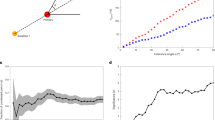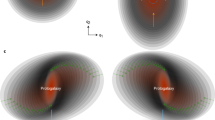Abstract
Recent work has shown that the Milky Way and the Andromeda galaxies both possess the unexpected property that their dwarf satellite galaxies are aligned in thin and kinematically coherent planar structures1,2,3,4,5,6,7. It is interesting to evaluate the incidence of such planar structures in the larger galactic population, because the Local Group may not be a representative environment. Here we report measurements of the velocities of pairs of diametrically opposed satellite galaxies. In the local Universe (redshift z < 0.05), we find that satellite pairs out to a distance of 150 kiloparsecs from the galactic centre are preferentially anti-correlated in their velocities (99.994 per cent confidence level), and that the distribution of galaxies in the larger-scale environment (out to distances of about 2 megaparsecs) is strongly clumped along the axis joining the inner satellite pair (>7σ confidence). This may indicate that planes of co-rotating satellites, similar to those seen around the Andromeda galaxy, are ubiquitous, and their coherent motion suggests that they represent a substantial repository of angular momentum on scales of about 100 kiloparsecs.
This is a preview of subscription content, access via your institution
Access options
Subscribe to this journal
Receive 51 print issues and online access
$199.00 per year
only $3.90 per issue
Buy this article
- Purchase on Springer Link
- Instant access to full article PDF
Prices may be subject to local taxes which are calculated during checkout



Similar content being viewed by others
References
Kroupa, P., Theis, C. & Boily, C. M. The great disk of Milky-Way satellites and cosmological sub-structures. Astron. Astrophys. 431, 517–521 (2005)
Pawlowski, M. S., Pflamm-Altenburg, J. & Kroupa, P. The VPOS: a vast polar structure of satellite galaxies, globular clusters and streams around the Milky Way. Mon. Not. R. Astron. Soc. 423, 1109–1126 (2012)
Pawlowski, M. S., Kroupa, P. & Jerjen, H. Dwarf galaxy planes: the discovery of symmetric structures in the Local Group. Mon. Not. R. Astron. Soc. 435, 1928–1957 (2013)
Pawlowski, M. S. & Kroupa, P. The rotationally stabilized VPOS and predicted proper motions of the Milky Way satellite galaxies. Mon. Not. R. Astron. Soc. 435, 2116–2131 (2013)
Ibata, R. A. et al. A vast, thin plane of corotating dwarf galaxies orbiting the Andromeda galaxy. Nature 493, 62–65 (2013)
Conn, A. R. et al. The three-dimensional structure of the M31 satellite system; strong evidence for an inhomogeneous distribution of satellites. Astrophys. J. 766, 120 (2013)
Ibata, R. A. et al. A thousand shadows of Andromeda: rotating planes of satellites in the Millennium-II cosmological simulation. Astrophys. J. 784, L6 (2014)
Lynden-Bell, D. Dwarf galaxies and globular clusters in high velocity hydrogen streams. Mon. Not. R. Astron. Soc. 174, 695–710 (1976)
Adelman-McCarthy, J. K. et al. The fourth data release of the Sloan Digital Sky Survey. Astrophys. J. 162 (supp.), 38 (2006)
Metz, M., Kroupa, P. & Jerjen, H. The spatial distribution of the Milky Way and Andromeda satellite galaxies. Mon. Not. R. Astron. Soc. 374, 1125–1145 (2007)
Metz, M., Kroupa, P. & Libeskind, N. I. The orbital poles of Milky Way satellite galaxies: a rotationally supported disk of satellites. Astrophys. J. 680, 287–294 (2008)
Metz, M., Kroupa, P. & Jerjen, H. Discs of satellites: the new dwarf spheroidals. Mon. Not. R. Astron. Soc. 394, 2223–2228 (2009)
McConnachie, A. W. et al. The remnants of galaxy formation from a panoramic survey of the region around M31. Nature 461, 66–69 (2009)
Ibata, R. A. et al. The large-scale structure of the halo of the Andromeda galaxy. I. Global stellar density, morphology and metallicity properties. Astrophys. J. 780, 128 (2014)
Conn, A. R. et al. A Bayesian approach to locating the red giant branch tip magnitude. II. Distances to the satellites of M31. Astrophys. J. 758, 11 (2012)
Tollerud, E. J. et al. The SPLASH survey: spectroscopy of 15 M31 dwarf spheroidal satellite galaxies. Astrophys. J. 752, 45 (2012)
Collins, M. L. M. et al. A kinematic study of the Andromeda dwarf spheroidal system. Astrophys. J. 768, 172 (2013)
Chiboucas, K., Jacobs, B. A., Tully, R. B. & Karachentsev, I. D. Confirmation of faint dwarf galaxies in the M81 group. Astron. J. 146, 126 (2013)
Bellazzini, M., Oosterloo, T., Fraternali, F. & Beccari, G. Dwarfs walking in a row. The filamentary nature of the NGC 3109 association. Astron. Astrophys. 559, L11 (2013)
Hammer, F. et al. The vast thin plane of M31 corotating dwarfs: an additional fossil signature of the M31 merger and of its considerable impact in the whole Local Group. Mon. Not. R. Astron. Soc. 431, 3543–3549 (2013)
Walker, M. in Planets, Stars and Stellar Systems Vol. 5 (eds Oswalt, T. & Gilmore, G. ) 1039–1089 (Springer, 2013)
Shaya, E. & Tully, B. The formation of Local Group planes of galaxies. Mon. Not. R. Astron. Soc. 436, 2096–2119 (2013)
Boylan-Kolchin, M., Springel, V., White, S. D. M., Jenkins, A. & Lemson, G. Resolving cosmic structure formation with the Millennium-II simulation. Mon. Not. R. Astron. Soc. 398, 1150–1164 (2009)
Guo, Q. et al. Galaxy formation in WMAP1 and WMAP7 cosmologies. Mon. Not. R. Astron. Soc. 428, 1351–1365 (2013)
Komatsu, E. et al. Seven-year Wilkinson Microwave Anisotropy Probe (WMAP) observations: cosmological interpretation. Astrophys. J. 192 (supp.), 18 (2011)
Bahl, H. & Baumgardt, H. A comparison of the distribution of satellite galaxies around Andromeda and the results of ΛCDM simulations. Mon. Not. R. Astron. Soc. 438, 2916–2923 (2014)
Blanton, M. R. et al. New York University Value-Added Galaxy Catalog: a galaxy catalog based on new public surveys. Astron. J. 129, 2562–2578 (2005)
Ade, P. A. R. et al. Planck 2013 results. XVI. Cosmological parameters. Preprint at http://arxiv.org/abs/1303.5076 (2013)
Strauss, M. A. et al. Spectroscopic target selection in the Sloan Digital Sky Survey: the main galaxy sample. Astron. J. 124, 1810–1824 (2002)
McMillan, P. J. Mass models of the Milky Way. Mon. Not. R. Astron. Soc. 414, 2446–2457 (2011)
Navarro, J. F., Frenk, C. S. & White, S. D. M. A universal density profile from hierarchical clustering. Astrophys. J. 490, 493–508 (1997)
Li, Y.-S. & White, S. D. M. Masses for the Local Group and the Milky Way. Mon. Not. R. Astron. Soc. 384, 1459–1468 (2008)
Acknowledgements
Funding for the SDSS and SDSS-II has been provided by the Alfred P. Sloan Foundation, the Participating Institutions, the National Science Foundation, the US Department of Energy, the National Aeronautics and Space Administration, the Japanese Monbukagakusho, the Max Planck Society and the Higher Education Funding Council for England. The Millennium-II simulation databases used in this paper and the web application providing online access to them were constructed as part of the activities of the German Astrophysical Virtual Observatory.
Author information
Authors and Affiliations
Contributions
All authors assisted in the development and writing of the paper. N.G.I. primarily contributed to the development of the test for planar alignments, and R.A.I. implemented this test on the SDSS galaxy catalogue.
Corresponding author
Ethics declarations
Competing interests
The authors declare no competing financial interests.
Extended data figures and tables
Extended Data Figure 1 Adopted velocity envelope relation.
Dots mark the distance–velocity distribution of satellites in the MS2 simulation that surround isolated host galaxies of similar luminosity and mass to the Milky Way32. The empirical envelope relation shown in red (300exp[−(300 kpc/R)0.8] km s−1) is used in our analysis as a means to reduce contamination from velocity outliers.
Rights and permissions
About this article
Cite this article
Ibata, N., Ibata, R., Famaey, B. et al. Velocity anti-correlation of diametrically opposed galaxy satellites in the low-redshift Universe. Nature 511, 563–566 (2014). https://doi.org/10.1038/nature13481
Received:
Accepted:
Published:
Issue Date:
DOI: https://doi.org/10.1038/nature13481
This article is cited by
-
A younger Universe implied by satellite pair correlations from SDSS observations of massive galaxy groups
Nature Astronomy (2024)
-
The Milky Way’s plane of satellites is consistent with ΛCDM
Nature Astronomy (2022)
-
Direct evidence of hierarchical assembly at low masses from isolated dwarf galaxy groups
Nature Astronomy (2017)
Comments
By submitting a comment you agree to abide by our Terms and Community Guidelines. If you find something abusive or that does not comply with our terms or guidelines please flag it as inappropriate.



